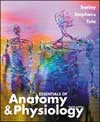 |  Essentials of Anatomy & Physiology, 4/e Rod R. Seeley,
Idaho State University
Philip Tate,
Phoenix College
Trent D. Stephens,
Idaho State University
The Urinary System and Fluid Balance
Study OutlineFunctions of the Urinary System Clinical Focus: Disorders of the Urinary
SystemExcretion p. 512-13
Blood volume control
Ion concentration regulation
pH regulation
Red blood cell concentration
Vitamin D synthesis
Urinary System(Fig. 18.1, p. 485, Fig. 18.2, p. 489)Kidneys(Fig. 18.3, p. 490) Renal capsule
Hilum of the kidney and renal sinus
Renal cortex and renal medulla
Renal pyramids and the calyces
Renal pelvis
The ureter
The nephron(Fig. 18.4, p. 491)Renal corpuscle(Fig. 18.5, p. 492)Glomerulus
Bowman's capsule
Filtration membrane
Fenestrated capillaries
Podocytes
Proximal tubule
Loop of Henle (nephronic loop)Descending limb
Ascending limb
Distal tubule
Collecting ducts
Arteries and veins(Fig. 18.6, p. 493)Renal arteries and veins
Interlobar arteries and veins
Arcuate arteries and veins
Interlobular arteries and veins
Afferent arterioles
Efferent arterioles
Peritubular capillaries and vasa recta
Juxtaglomerular apparatus
Ureters, urinary bladder, and urethra(Fig. 18.7, p. 494)Trigone of bladder and urethra
Urinary sphincters
Internal urinary sphincter -smooth muscle
External urinary sphincter -skeletal muscle
Differences between the sexes
Urine Production (Fig. 18.8 and Tbl. 18.1, p. 487 )Filtration
Filtration membrane
Filtrate
Filtration pressure(Fig. 18.9, p. 496) Reabsorption
Water(Fig. 18.10, p. 497) Proximal tubules(Fig. 18.11, p. 498)Descending limb of loop of Henle(Fig. 18.12, p. 499) Ascending limb of loop of Henle(Fig. 18.13, p. 499) Distal tubules and collecting ducts(Fig. 18.14, p. 500) Secretion
Regulation of Urine Concentration and Volume(Fig. 18.16, p. 502)Hormonal mechanisms
Antidiuretic hormone (ADH)(Fig. 18.15, p. 501)Renin-angiotensin-aldosterone
Renin & juxtaglomerular complex
Angiotensin I and II
Aldosterone
Atrial natriuretic hormone Effect of Sympathetic Innervation
on Kidney Function
Urine Movement-Micturition Reflex(Fig. 18.17, p. 505)Body Fluid Compartments (Table 18.2, p. 505)Comparison of fluids in each compartment
Exchange between body fluid compartments
Regulation of Extracellular Fluid Composition
Thirst
Ions
Sodium ions(Fig. 18.18, p. 507)Potassium ions(Fig. 18.19, p. 508)Calcium ions(Fig. 18.20, p. 509)Phosphate and sulfate ions
Regulation of Acid-Base Balance(Fig. 18.21, p. 511)Buffers
Proteins
Phosphates
Bicarbonate
Respiratory system
Kidneys
Metabolic
Respiratory
Alkalosis
Metabolic
Respiratory
Systems Pathology -Acute Renal FailureSystems Interaction Table p. 515
|
|



 2002 McGraw-Hill Higher Education
2002 McGraw-Hill Higher Education